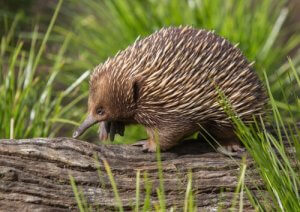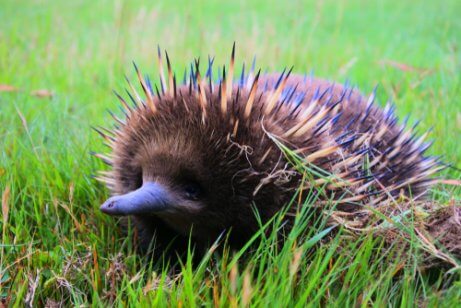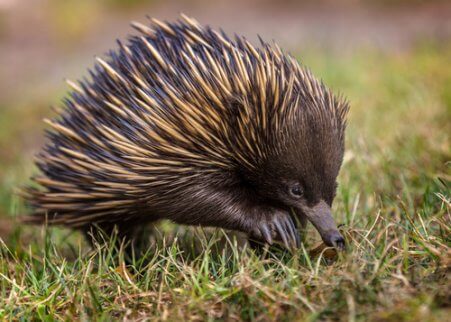Have You Heard About the Curious Echidna?


Written and verified by the biotechnologist Alejandro Rodríguez
Even though at first glance it may appear to be a hedgehog, the characteristics of the curious echidna are truly unique.
The echidna (Tachyglossus aculeatus) is, without a doubt, a unique animal. It belongs to the Tachyglossidae family and the subspecies Tachyglossa. In fact, it’s the only animal in this subspecies.
These unusual animals owe their name to Echidna, a nymph in Greek mythology considered to be the mother of many legendary monsters. But, why are these animals so unique?
Characteristics of the curious echidna
The body of the echidna is compact and round, measuring between 12 to 20 inches and weighing up to 15.5 pounds. It has thick fur and long barbed quills composed of keratin. Conveniently, the quills act as a defense mechanism against predators.
The echidna has a long snout. It houses a long and sticky tongue that’s almost 8 inches long and is very handy for eating its diet of insects and worms. In place of teeth, there are spines in the roof of its mouth for chewing food.

Echidnas are known to be great diggers. This is due to their powerful front paws as well as their back paws. The second digits on their back paws are larger than the rest of the digits. Therefore, they use them to scratch and clean themselves.
Reproduction and lactation
When reproducing, the female lays one single egg. The incubation period is 10 days and it takes place in the marsupium. Like that of the kangaroo, it has a pouch in the skin where babies stay for approximately 45 days.
The method of lactation of the little echidnas is also unique. Lacking nipples, the female secretes milk through the pores of her skin to feed the babies. Later, when they start to develop quills, she digs a burrow as a safe haven for her young. Then, 7 months later, the young echidna is ready to survive on its own.

These animals have long lives. In fact, there are registered cases of echidnas that have lived to be more than 50 years old.
The habitat of the curious echidna
This one-of-a-kind animal lives in New Zealand, Tasmania, Australia, and New Guinea. Generally speaking, it’s difficult to spot since it’s a nocturnal creature.
In spite of what we may think, the echidna doesn’t hibernate. However, it enters into a deep sleep when the temperature goes above 77 degrees. As we can see, it’s one of the most curious and extraordinary animals to inhabit the earth.
Even though at first glance it may appear to be a hedgehog, the characteristics of the curious echidna are truly unique.
The echidna (Tachyglossus aculeatus) is, without a doubt, a unique animal. It belongs to the Tachyglossidae family and the subspecies Tachyglossa. In fact, it’s the only animal in this subspecies.
These unusual animals owe their name to Echidna, a nymph in Greek mythology considered to be the mother of many legendary monsters. But, why are these animals so unique?
Characteristics of the curious echidna
The body of the echidna is compact and round, measuring between 12 to 20 inches and weighing up to 15.5 pounds. It has thick fur and long barbed quills composed of keratin. Conveniently, the quills act as a defense mechanism against predators.
The echidna has a long snout. It houses a long and sticky tongue that’s almost 8 inches long and is very handy for eating its diet of insects and worms. In place of teeth, there are spines in the roof of its mouth for chewing food.

Echidnas are known to be great diggers. This is due to their powerful front paws as well as their back paws. The second digits on their back paws are larger than the rest of the digits. Therefore, they use them to scratch and clean themselves.
Reproduction and lactation
When reproducing, the female lays one single egg. The incubation period is 10 days and it takes place in the marsupium. Like that of the kangaroo, it has a pouch in the skin where babies stay for approximately 45 days.
The method of lactation of the little echidnas is also unique. Lacking nipples, the female secretes milk through the pores of her skin to feed the babies. Later, when they start to develop quills, she digs a burrow as a safe haven for her young. Then, 7 months later, the young echidna is ready to survive on its own.

These animals have long lives. In fact, there are registered cases of echidnas that have lived to be more than 50 years old.
The habitat of the curious echidna
This one-of-a-kind animal lives in New Zealand, Tasmania, Australia, and New Guinea. Generally speaking, it’s difficult to spot since it’s a nocturnal creature.
In spite of what we may think, the echidna doesn’t hibernate. However, it enters into a deep sleep when the temperature goes above 77 degrees. As we can see, it’s one of the most curious and extraordinary animals to inhabit the earth.
All cited sources were thoroughly reviewed by our team to ensure their quality, reliability, currency, and validity. The bibliography of this article was considered reliable and of academic or scientific accuracy.
- Nicol, S. C., Andersen, N. A., Morrow, G. E., & Harris, R. L. (2018). Spurs, sexual dimorphism and reproductive maturity in Tasmanian echidnas (Tachyglossus aculeatus setosus). Australian Mammalogy.
- Morrow, G. E., Jones, S. M., & Nicol, S. C. (2016). Interaction of hibernation and male reproductive function in wild Tasmanian echidnas Tachyglossus aculeatus setosus. Journal of Mammalogy, 97(3), 852-860.
This text is provided for informational purposes only and does not replace consultation with a professional. If in doubt, consult your specialist.








